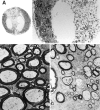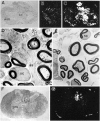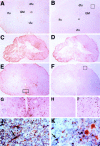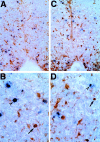Myelin gene expression after experimental contusive spinal cord injury
- PMID: 9786985
- PMCID: PMC6793561
- DOI: 10.1523/JNEUROSCI.18-21-08780.1998
Myelin gene expression after experimental contusive spinal cord injury
Abstract
After incomplete traumatic spinal cord injury (SCI), the spared tissue exhibits abnormal myelination that is associated with reduced or blocked axonal conductance. To examine the molecular basis of the abnormal myelination, we used a standardized rat model of incomplete SCI and compared normal uninjured tissue with that after contusion injury. We evaluated expression of mRNA for myelin proteins using in situ hybridization with oligonucleotide probes to proteolipid protein (PLP), the major protein in central myelin; myelin basic protein (MBP), a major component of central myelin and a minor component of peripheral myelin; and protein zero (P0), the major structural protein of peripheral myelin, as well as myelin transcription factor 1 (MYT1). We found reduced expression of PLP and MBP chronically after SCI in the dorsal, lateral, and ventral white matter both rostral and caudal to the injury epicenter. Detailed studies of PLP at 2 months after injury indicated that the density of expressing cells was normal but mRNA per cell was reduced. In addition, P0, normally restricted to the peripheral nervous system, was expressed both at the epicenter and in lesioned areas at least 4 mm rostral and caudal to it. Thus, after SCI, abnormal myelination of residual axons may be caused, at least in part, by changes in the transcriptional regulation of genes for myelin proteins and by altered distribution of myelin-producing cells. In addition, the expression of MYT1 mRNA and protein seemed to be upregulated after SCI in a pattern suggesting the presence of undifferentiated progenitor cells in the chronically injured cord.
Figures













Similar articles
-
The expression of myelin basic protein exon 1 and exon 2 containing transcripts during myelination of the neonatal rat spinal cord--an in situ hybridization study.J Neurocytol. 1998 Sep;27(9):683-93. doi: 10.1023/a:1006972316697. J Neurocytol. 1998. PMID: 10447242
-
Effects of progesterone on oligodendrocyte progenitors, oligodendrocyte transcription factors, and myelin proteins following spinal cord injury.Glia. 2009 Jun;57(8):884-97. doi: 10.1002/glia.20814. Glia. 2009. PMID: 19053058
-
Demyelination and Schwann cell responses adjacent to injury epicenter cavities following chronic human spinal cord injury.Exp Neurol. 2005 Apr;192(2):384-93. doi: 10.1016/j.expneurol.2004.11.033. Exp Neurol. 2005. PMID: 15755556
-
Regulation of myelin-specific gene expression. Relevance to CMT1.Ann N Y Acad Sci. 1999 Sep 14;883:91-108. Ann N Y Acad Sci. 1999. PMID: 10586235 Review.
-
Mechanisms of myelin basic protein and proteolipid protein targeting in oligodendrocytes (review).Mol Membr Biol. 1994 Apr-Jun;11(2):67-78. doi: 10.3109/09687689409162223. Mol Membr Biol. 1994. PMID: 7522797 Review.
Cited by
-
Sensory afferents regenerated into dorsal columns after spinal cord injury remain in a chronic pathophysiological state.Exp Neurol. 2007 Aug;206(2):257-68. doi: 10.1016/j.expneurol.2007.05.013. Epub 2007 May 23. Exp Neurol. 2007. PMID: 17585905 Free PMC article.
-
Coordination of the bladder detrusor and the external urethral sphincter in a rat model of spinal cord injury: effect of injury severity.J Neurosci. 2001 Jan 15;21(2):559-69. doi: 10.1523/JNEUROSCI.21-02-00559.2001. J Neurosci. 2001. PMID: 11160435 Free PMC article.
-
Loss of Myt1 function partially compromises endocrine islet cell differentiation and pancreatic physiological function in the mouse.Mech Dev. 2007 Nov-Dec;124(11-12):898-910. doi: 10.1016/j.mod.2007.08.004. Epub 2007 Sep 4. Mech Dev. 2007. PMID: 17928203 Free PMC article.
-
The Role of Inflammatory Cascade and Reactive Astrogliosis in Glial Scar Formation Post-spinal Cord Injury.Cell Mol Neurobiol. 2024 Nov 23;44(1):78. doi: 10.1007/s10571-024-01519-9. Cell Mol Neurobiol. 2024. PMID: 39579235 Free PMC article. Review.
-
Axonal remyelination by cord blood stem cells after spinal cord injury.J Neurotrauma. 2007 Feb;24(2):391-410. doi: 10.1089/neu.2006.0142. J Neurotrauma. 2007. PMID: 17376002 Free PMC article.
References
-
- Armstrong RC, Kim JG, Hudson LD. Expression of myelin transcription factor I (MyTI), a “zinc-finger” DNA-binding protein, in developing oligodendrocytes. Glia. 1995;14:303–321. - PubMed
-
- Armstrong RC, Migneault A, Shegog ML, Kim JG, Hudson LD, Hessler RB. High-grade human brain tumors exhibit increased expression of myelin transcription factor 1 (MYT1), a zinc finger DNA-binding protein. J Neuropathol Exp Neurol. 1997;56:772–781. - PubMed
-
- Balentine JD. Pathology of experimental spinal cord trauma. II. Ultrastructure of axons and myelin. Lab Invest. 1978;39:254–266. - PubMed
-
- Bhat RV, Axt KJ, Fosnaugh JS, Smith KJ, Johnson KA, Hill DE, Kinzler KW, Baraban JM. Expression of the APC tumor suppressor protein in oligodendroglia. Glia. 1996;17:169–174. - PubMed
Publication types
MeSH terms
Substances
Grants and funding
LinkOut - more resources
Full Text Sources
Other Literature Sources
Medical
Research Materials
Miscellaneous
